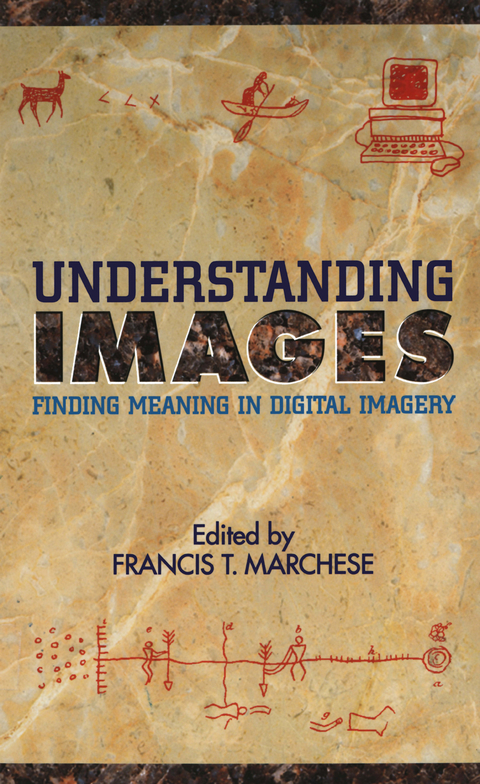
Understanding Images
Springer-Verlag New York Inc.
978-0-387-94148-6 (ISBN)
- Titel z.Zt. nicht lieferbar
- Versandkostenfrei
- Auch auf Rechnung
- Artikel merken
This is a broad-ranging, cross-disciplinary collection of exciting and readable materials as diverse in content as Lipstick on the Bulldog (product design) and Masaccio's Bag of Tricks (3D graphics and Renaissance art), to Is Alligator Skin More Wrinkled Then Tree Bark? (visual textures) and Crossroads in Virtual Reality (philosophy of virtual worlds). The fourteen contributions contained in this volume are authored by artists, designers, scientists, psychologists, philosophers and educators. While diverse in content, the selections nonetheless focus on the basic underlying theme explored at the Conference on Understanding Images, which was held at the Manhattan Campus of Pace University in New York City and co-sponsored by the New York City Chapter of the Association of Computing Machinery (ACM) and Pace University's School of Computer Science and Information Systems. The Conference's theme was: how do we understand the complicated, interdisciplinary world of electronic imagery, and what are the means and techniques we employ to visually convey these images to others? These presentations not only pinpoint interesting and complex issues confronting researchers and practitioners, but they also define the problem domains and offer future solution strategies.
1 Editor’s Introduction.- 1.1 References.- 2 Lipstick on the Bulldog.- 2.1 Introduction.- 2.2 A Few Definitions.- 2.3 Why Collaboration is Hard to Do.- 2.4 Process, Tools, Product.- 2.5 Strategists or Service Bureaus.- 2.6 Education.- 2.7 Common Ground.- 3 Photographic Interpretation.- 3.1 Introduction.- 3.2 Questions and Answers.- 4 Cognitive Origins of Graphic Productions.- 4.1 Introduction.- 4.2 Pictographs and Symbols.- 4.3 Pictorial Space and Pictorial Devices.- 4.4 Conclusions.- 4.5 Acknowledgements.- 4.6 References.- 5 Automating Procedures for Generating Chinese Characters.- 5.1 Introduction.- 5.2 The Case for Chinese Characters.- 5.3 Introduction to Chinese Characters.- 5.4 Current Software Capabilities.- 5.5 The Path Based Bezier Curve Approach.- 5.6 References.- 6 Multimedia Representational Aids in Urban Planning Support Systems.- 6.1 Introduction.- 6.2 Challenges to Urban Planning Support Systems.- 6.3 Addressing the Challenges: Representational Aids.- 6.4 Input Aids.- 6.5 Output Aids.- 6.6 Application of Representational Aids: Rantoul, Illinois.- 6.7 Conclusions.- 6.8 Acknowledgements.- 6.9 References.- 7 Gesture Translation:Using Conventional Musical Instruments in Unconventional Ways.- 7.1 Introduction.- 7.2 The Need for Something Better.- 7.3 Gesture Translation.- 7.4 The Current System.- 7.5 An Example.- 7.6 Related Work.- 7.7 Limitations and Future Work.- 7.8 Conclusion.- 7.9 References.- 8 Visualization for Personal Information Systems.- 8.1 Introduction.- 8.2 Personal Information Systems.- 8.3 Personal Knowledge Space.- 8.4 Discussion.- 8.5 Summary and Future Research.- 8.6 References.- 9 Blazon Computer Graphic Notation.- 9.1 Overview and Background.- 9.2 Basic Terms and Definitions.- 9.3 The Marshalling of Arms.- 9.4 Summary of Blazon.- 9.5References.- 10 Masaccio’s Bag of Tricks.- 10.1 Introduction.- 10.2 The Perspective and Plan of Masaccio’s Trinity.- 10.3 Convincing Realism or Subtle Rhetoric Tricks?.- 10.4 Conclusion.- 10.5 Acknowledgements.- 10.6 References.- 11 Is Alligator Skin More Wrinkled Than Tree Bark?.- 11.1 Introduction.- 11.2 Benefits of This Research.- 11.3 Primary versus Secondary Properties of Objects.- 11.4 How to Think About Texture.- 11.6 Experiments on the Categorization of Texture Words.- 11.7 Conclusion.- 11.8 References.- 12 Variability and Universality in Human Image Processing.- 12.1 Introduction.- 12.2 Background.- 12.3 An Information Oriented Model for Understanding Imagery.- 12.4 References.- 13 Aesthetics and Nature.- 13.1 Introduction.- 13.2 Scientific Visualization as a Coherent Window into a (Fragmented) World.- 13.3 Spatial and Temporal (Dis)continuities.- 13.4 The Multiple Roles of the Visualization Expert.- 13.5 Case Studies.- 13.6 Conclusion.- 13.7 References.- 14 Crossroads in Virtual Reality.- 14.1 Introduction.- 14.2 The Meanings of Virtual Reality, Virtual Worlds, Virtual Environments.- 14.3 VR Projection Images Do Not Re-Present, They Tele-Present.- 14.4 References.- 15 Audio Display from the Simple Beep to Sonification and Virtual Auditory Environments.- 15.1 Introduction.- 15.2 Motivations for the Use of Audio.- 15.3 Auditory Perception.- 15.4 Auditory Scene Analysis.- 15.5 Detectability and Masking.- 15.6 The Psychology of Everyday Listening.- 15.7 Approaches and Applications of Audio Displays.- 15.8 Displaying Abstract Data: Sonification and Auralization.- 15.9 Virtual Auditory Worlds.- 15.10 Future Research.- 15.11 Implementation Issues.- 15.12 Conclusions.- 15.13 References.- 16 Contibutors.
| Zusatzinfo | XII, 316 p. |
|---|---|
| Verlagsort | New York, NY |
| Sprache | englisch |
| Themenwelt | Informatik ► Grafik / Design ► Digitale Bildverarbeitung |
| Informatik ► Theorie / Studium ► Künstliche Intelligenz / Robotik | |
| ISBN-10 | 0-387-94148-7 / 0387941487 |
| ISBN-13 | 978-0-387-94148-6 / 9780387941486 |
| Zustand | Neuware |
| Haben Sie eine Frage zum Produkt? |
aus dem Bereich


